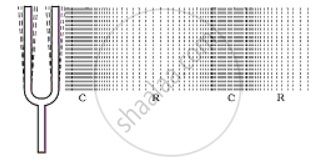Advertisements
Advertisements
प्रश्न
Distinguish between compression and rarefaction.
उत्तर
A longitudinal wave propagates by means of compressions and rarefactions.
When a vibrating object moves forward, it pushes and compresses the air in front of it creating a region of high pressure. This region is called a compression (C), as shown in Fig. This compression starts to move away from the vibrating object. When the vibrating object moves backwards, it creates a region of low pressure called rarefaction (R), as shown in Fig.

A vibrating object creating a series of compressions (C)
and rarefactions (R) in the medium
Compressions are the regions of high density where the particles of the medium come very close to each other and rarefactions are the regions of low density where the particles of the medium move away from each other.
APPEARS IN
संबंधित प्रश्न
Name the characteristic which differentiates two sounds of the same pitch and same loudness.
Describe an experiment to show the production of sound having low and high pitch.
Define the term intensity of a sound wave. State the unit in which it is measured.
Define the term amplitude of a wave. Write its S.I. unit.
The distance between three consecutive crests of wave is 60 cm. If the waves are produced at the rate of 180/ min, calculate:
- wavelength
- time period
- wave velocity.
How is sound produced?
Can you hear each other in a dark room?
Distinguish between light and sound waves. What are the consequences of the large difference in the speed of sound and that of light? Briefly explain them.
Unwanted sounds are called ______.
